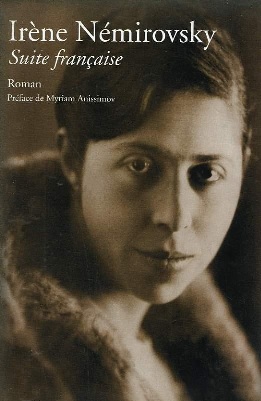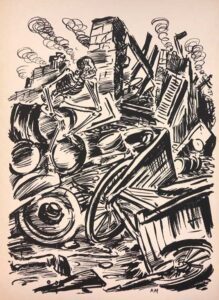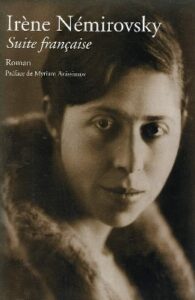
by Frances Oliver

I wrote recently about a just republished book from my parents’ art book collection, Saul Steinberg’s Labyrinth. Another of their books I treasure, a very different book that some might find almost unbearable to look at, is Frans Masereel’s Danse Macabre, the drawings that are his own 20th-century version of the plague-inspired medieval Dance of Death. I had always assumed that Masereel was one of the group of European artists, like Kathe Kollwitz and George Grosz, whose sombre works were inspired by the First World War and the great influenza epidemic that followed it. I had missed a thin sheet of paper inside the cover of my parents’ edition, which is all the text in or with the book. In a letter to his publisher, Masereel in his simple manner describes his personal share in the tragedy of our times: “We have lived through tragic days, having left Paris on foot! We have walked for nearly 300 miles, have been bombed and machine-gunned several times a day, and finally got stranded in an old mill, where we lived for a month on a litter of straw. Now we are with friends, which is somewhat more comfortable. I cannot paint, as there is nothing to paint with. So I am now working out in black and white the sketches which I made during the retreat, or rather the debacle!”
This makes Masereel’s grim book doubly fascinating, because a novel posthumously published and now hailed as one of the finest of the 20th century deals with precisely the same event, the exodus from Paris when the Germans invaded in 1940 – Irene Nemirovsky’s Suite Française.
Frans Masereel (1889-1972), a Belgian painter and graphic artist renowned chiefly for his Expressionist woodcuts, lived and worked mostly in France. Often the woodcuts took a form he described as “novels in pictures”, wordless scenes depicting a narrative. Later he turned to doing variations on a theme instead. He also illustrated books by such literary masters as Zola, Stefan Zweig and Thomas Mann.
Masereel’s Death, occasionally sly or pensive but mostly grinning and always triumphant, is shown in 25 varied scenes. Death smiles from a tank, Death whips a dying horse, Death leads a stream of refugees, Death rides a torpedo, Death lurks behinds a couple of lovers, Death with a tattered banner marches at an army’s head… and lastly sits, bone elbows on counter, skull in hands, under a sign saying plus de pain. No more bread. Masereel has made his experience of the flight from Paris into a sweeping epic vision, using a Gothic tradition from the plague years for a modern work of art which “meets in intensity the tragic grandeur of world disaster, the whole disaster of the war.” I would not have said grandeur as his publisher did, but rather enormity – for grandeur is what Death, with all else, takes away.
Masereel was a pacifist who refused to serve in the Belgian army in World War I. It is not surprising that in his book there are no individuals, only nameless children, women and men, no allies of Death, only victims. A very different impression of the Paris exodus is what seems to have inspired Irene Nemirovsky’s superb novel, part of a longer work she did not live to complete.
Nemirovsky does have villains, mostly among the protected, the celebrities, the rich, those who see themselves distinctly as an upper class. Her focus is on individuals; her precision and acuteness in delineating  characters and single episodes is a direct counterpart to Masereel’s epic sweep. One could give endless quotes showing Nemirovsky’s skill in pin-pointing a character with a sentence; and the characters – their ignorance, selfishness, opportunism and greed are judged with a sardonic unblinking eye. Among the varied refugees whose fates Nemirovsky follows, there are only four whose decency is unfailing. Three are a couple of small-time bank employees and their soldier son. Jeanne and Maurice Michaux, sustained by their love for each other, never lose their hope, their morality, their courage and initiative. When in the panic following a German bombing-raid children and mothers are separated, Jeanne takes it on herself to assemble the frightened children, then call the mothers to come and get their own, no doubt saving at least several lives – an act for which none of the mothers even thanks her.
characters and single episodes is a direct counterpart to Masereel’s epic sweep. One could give endless quotes showing Nemirovsky’s skill in pin-pointing a character with a sentence; and the characters – their ignorance, selfishness, opportunism and greed are judged with a sardonic unblinking eye. Among the varied refugees whose fates Nemirovsky follows, there are only four whose decency is unfailing. Three are a couple of small-time bank employees and their soldier son. Jeanne and Maurice Michaux, sustained by their love for each other, never lose their hope, their morality, their courage and initiative. When in the panic following a German bombing-raid children and mothers are separated, Jeanne takes it on herself to assemble the frightened children, then call the mothers to come and get their own, no doubt saving at least several lives – an act for which none of the mothers even thanks her.
The other selfless character is a naïve, deeply religious young priest, eldest son of a wealthy, supremely class-conscious and ambitious mother, Madame Pericand-Mâltete. Nemirovsky seems to take particular delight in exposing her hypocrisies and her fixation on the image she presents. In one of the book’s best black comedy scenes, Madame Pericand is priding herself on having got her large family onto a train after a horrendous car journey, all children, pets, servants and not least family jewels intact – and realizes suddenly there is something she has left behind: her disabled senile father-in-law. In the book’s most harrowing scene, her son, the young priest, is brutally killed – not by German guns or bombs but by the group of delinquent orphan boys he has been asked to evacuate from Paris. With ultimate irony, they are the boys from a charitable institution founded by his grandfather Pericand.
Irene Nemirovsky (1903-1942) was the daughter of a wealthy Russian Jewish banker. After the Revolution, the family fled, finally making their home in France where they continued to prosper. The young Irene led a happy social life with many balls and flirtations and had much literary success with her first novel, David Golder. She married another banker, Michel Epstein. Although the Epsteins, seeing dark days ahead, converted to Catholicism and fled again with their small daughters from Paris to a country village, they were eventually arrested and deported. Both died in Auschwitz in 1942. Their daughters were disguised and hidden for the rest of the war and managed to keep a suitcase that contained their mother’s last manuscript, Suite Française, finally published in 2004.
I would have liked to write about yet another artistic take on the 1940 flight from Paris, a heart-breaking, unforgettable little French film called Jeux Interdits, Forbidden Games, but that will have to wait until I can see it again.
In the midst of the Coronavirus crisis, Nemirovsky’s dark portrait of a corrupt society faced with debacle is more relevant than ever. We must hope that here the Michauxs will outnumber the Pericands, the queue-jumpers and hoarders and shelf-strippers. Meanwhile the virus has upstaged the greater crisis that awaits if our political and economic systems, our massive consumption, go back to being what they were. If world temperature increases by three degrees, in the massive exodus that will follow, who, for anyone left to peruse them, will be our Irene Nemirovsky, our Frans Masereel?
Volume 34 no 5 May / June 2020

